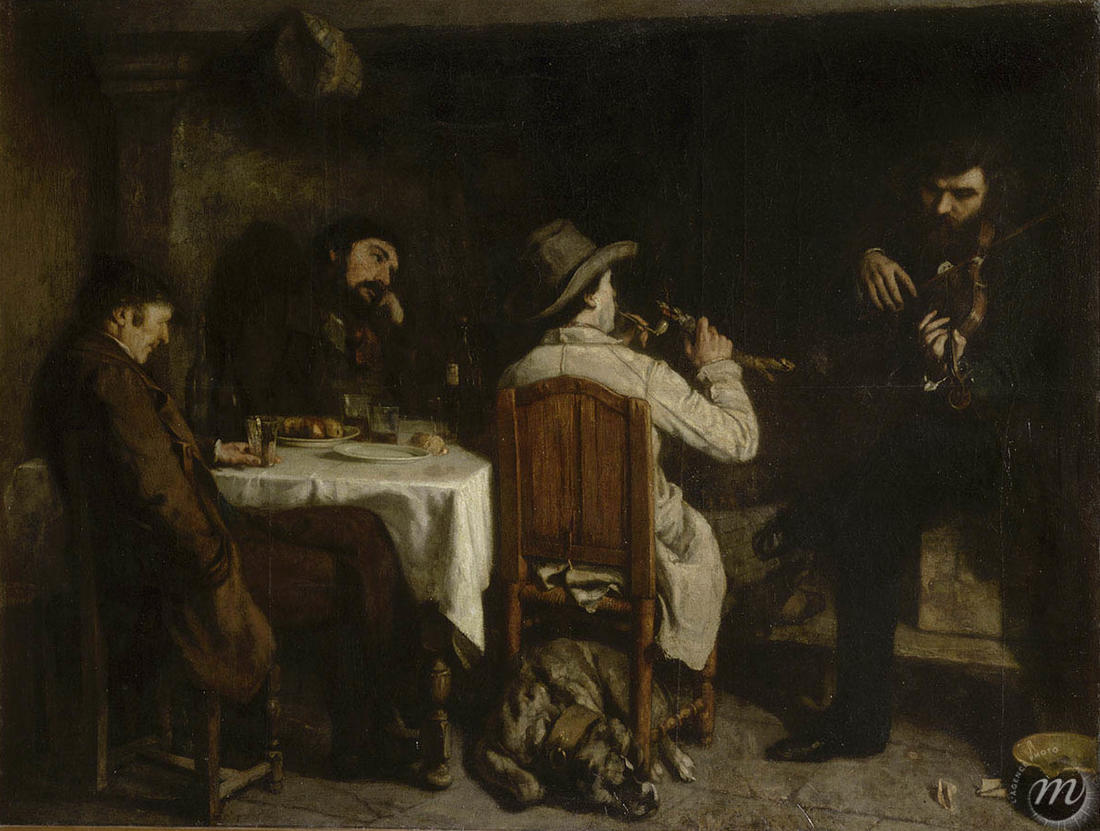Normally, in fact, this kind of interior scene, with its intimate feel, was treated in a small format. Here, Courbet clearly wanted to create surprise by using a format which was then reserved for historical painting. By doing this, he elevated a mundane reunion of friends to the rank of an heroic event. It tears up the rule book and passes into posterity.
Courbet himself describes the scene: "It was November, we were at our friend Cuenot's house, Marlet had returned from hunting and we had engaged Promayet to play the violin before my father." Régis Courbet, the artist's father, sits on the left, holding his glass in his hand. In the centre, seen from behind, it is his friend Marlet who is lighting his pipe. Under his chair, a huge dog is sleeping. In the background, thoughtful, is the host, Urbain Cuenot.
Ingres, who defended the classical ideal, was concerned about this "dangerous" work, Delacroix was ecstatic: "Have you ever seen anything like it, seen anything so strong? He is an innovator, a revolutionary! "
The entry of the painting into the museum of Lille marked the beginning of a long story of friendship between the painter and the institution. Once it was hung, the artist wrote to the curator, Reynart: Had I chosen a location, I would certainly have chosen one less beautiful and honourable.
This painting is considered as the ultimate expression of the realistic movement in France.
Inventory number: P. 522
Detail 1: Remembering the lesson of Dutch masters like Rembrandt, Courbet takes care with the lighting.
Detail 2: Taking a different approach, away from the fresh and delicate tones of the academic painters, Courbet chose a dull, earthy palette made of up greys and browns which gives a rustic character to the ensemble.

Normally, in fact, this kind of interior scene, with its intimate feel, was treated in a small format. Here, Courbet clearly wanted to create surprise by using a format which was then reserved for historical painting. By doing this, he elevated a mundane reunion of friends to the rank of an heroic event. It tears up the rule book and passes into posterity.
Courbet himself describes the scene: "It was November, we were at our friend Cuenot's house, Marlet had returned from hunting and we had engaged Promayet to play the violin before my father." Régis Courbet, the artist's father, sits on the left, holding his glass in his hand. In the centre, seen from behind, it is his friend Marlet who is lighting his pipe. Under his chair, a huge dog is sleeping. In the background, thoughtful, is the host, Urbain Cuenot.
Ingres, who defended the classical ideal, was concerned about this "dangerous" work, Delacroix was ecstatic: "Have you ever seen anything like it, seen anything so strong? He is an innovator, a revolutionary! "
The entry of the painting into the museum of Lille marked the beginning of a long story of friendship between the painter and the institution. Once it was hung, the artist wrote to the curator, Reynart: Had I chosen a location, I would certainly have chosen one less beautiful and honourable.
This painting is considered as the ultimate expression of the realistic movement in France.
Inventory number: P. 522
Detail 1: Remembering the lesson of Dutch masters like Rembrandt, Courbet takes care with the lighting.
Detail 2: Taking a different approach, away from the fresh and delicate tones of the academic painters, Courbet chose a dull, earthy palette made of up greys and browns which gives a rustic character to the ensemble.